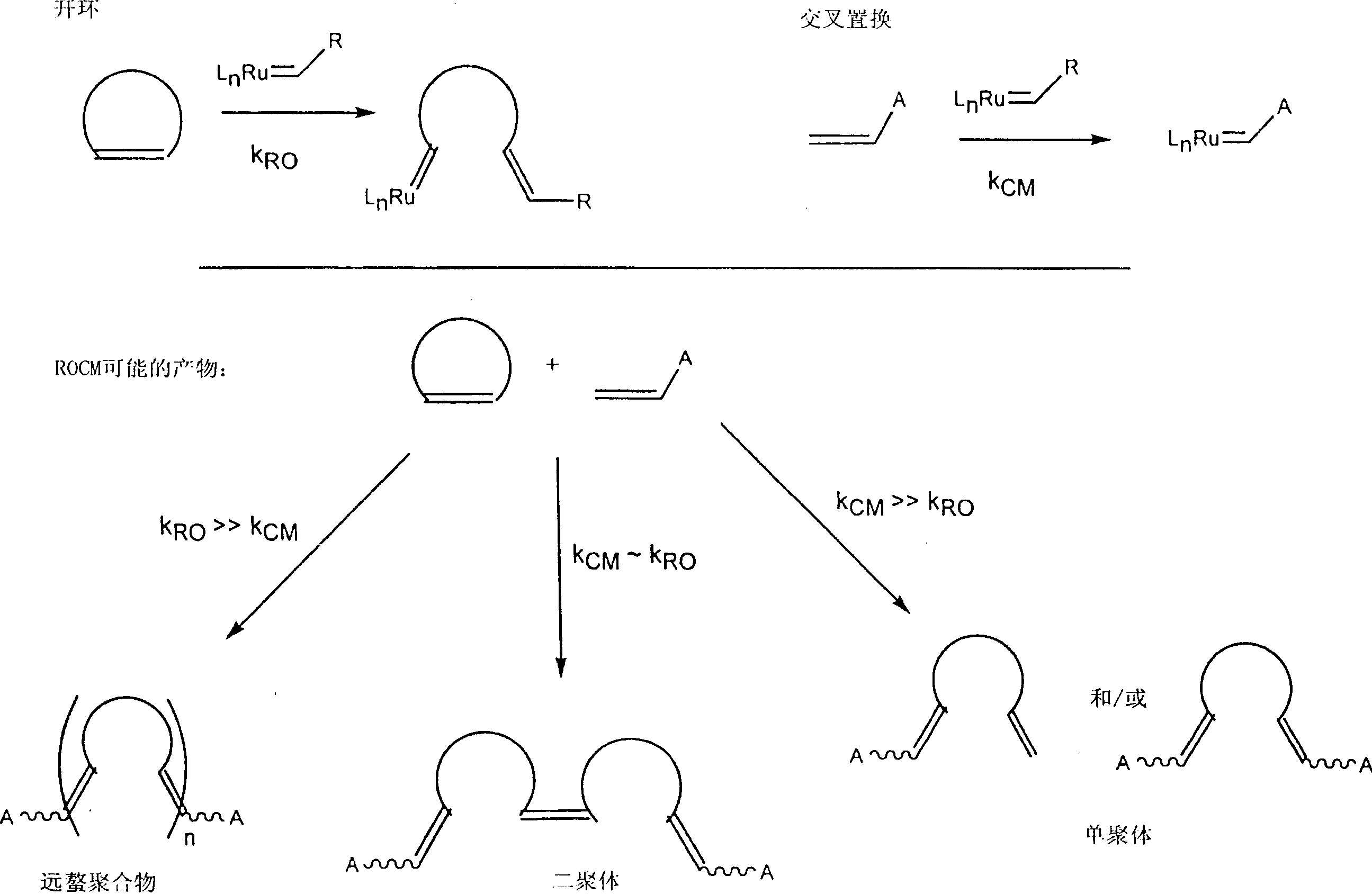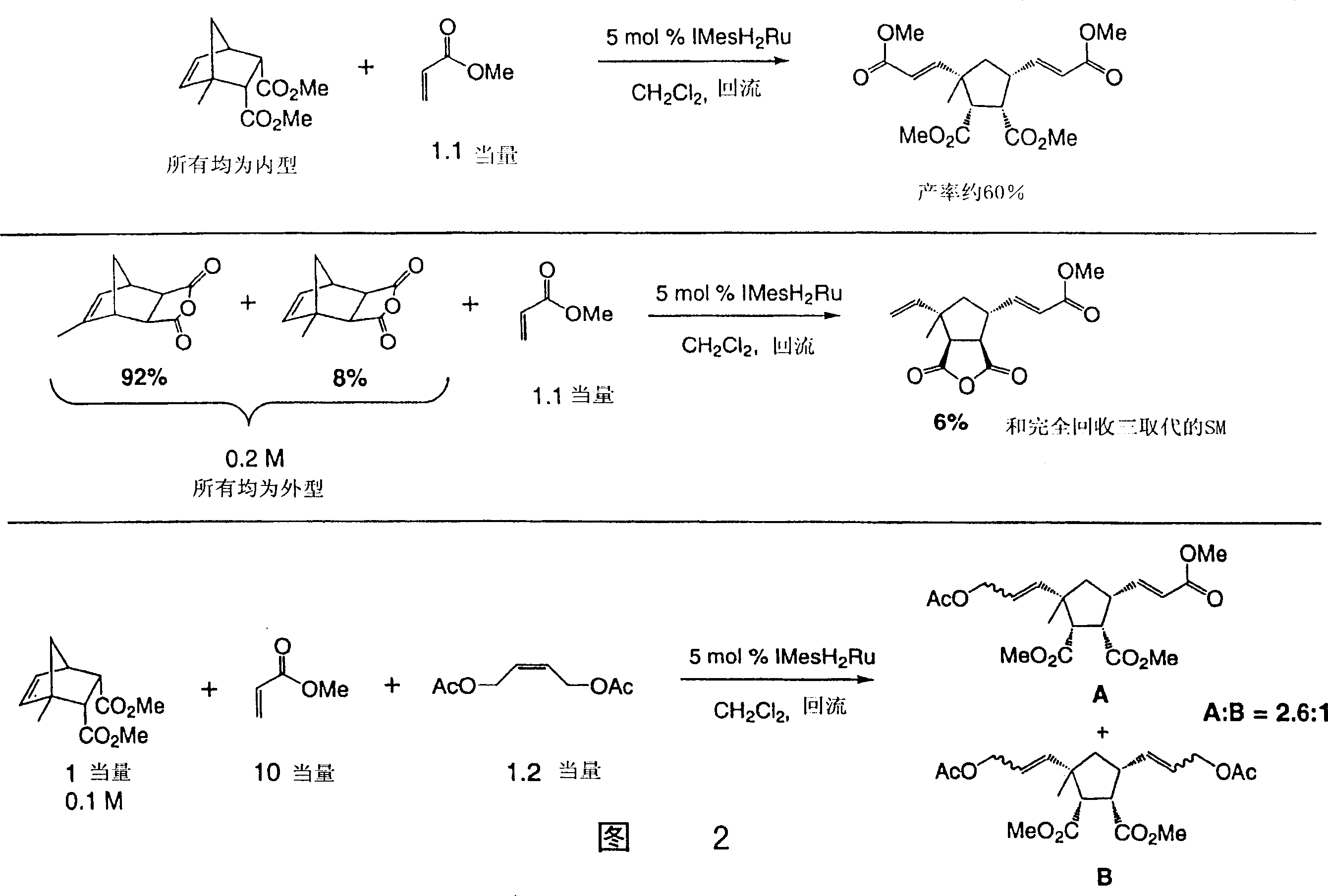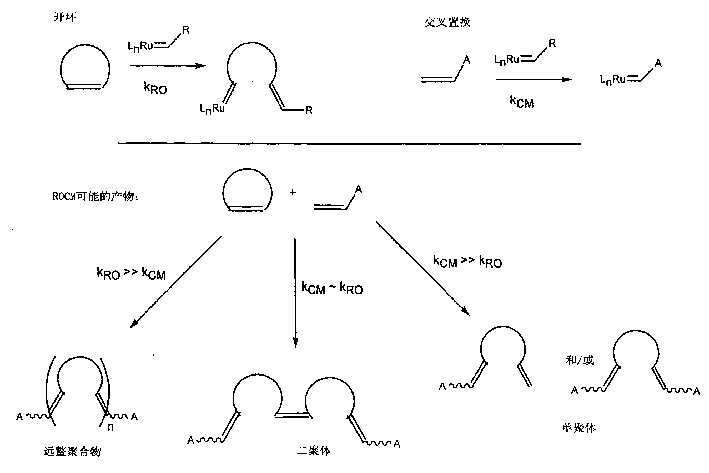Selective ring-opening cross-metathesis of cycloulefins
A cross-replacement and cyclic olefin technology, which is used in the production of hydrocarbons by metathesis reaction, the preparation of organic compounds, and compounds containing elements of Group 8/9/10/18 of the periodic table, etc., and can solve problems such as variation.
- Summary
- Abstract
- Description
- Claims
- Application Information
AI Technical Summary
Problems solved by technology
Method used
Image
Examples
Embodiment 1
[0180] Synthesis of RuCl 2 (=CH-CH=C(CH 3 ) 2 ) (IMesH 2 )(PCy 3 ) (complex (2), route 1):
[0181]
[0182]
[0183] Pathway 1
[0184] Weigh directly into the main 600mL Schlenk tube and add [Ru(COD)Cl 2 ] n (300mg, 1mmol), IMesH 2 Cl (1.47g, 4mmol), tricyclohexylphosphine (300mg, 1mmol) and KN (SiMe 3 ) 2 (540 mg, 2.5 mmol). The flask was evacuated and filled with dry argon (2x). Degassed benzene (300 mL) was added and the flask was pressurized to 30 psi with H2. The suspension was stirred vigorously at 90°C for 12 hours, resulting in a pale yellow solution and a white deposit (1). After cooling the reaction to 5 °C, propargyl chloride (0.3 mL, 4 mmol) was added slowly via syringe and the reaction mixture was warmed to room temperature. The resulting brown benzene solution was washed with degassed 1M HCl (2x) and degassed brine (2x), filtered through celite, and concentrated in vacuo to afford compound (2) as a brown solid in 90% yield ( ~95% purity). ...
Embodiment 2
[0187] Synthesis of RuCl 2 (=CH-CH=C(CH 3 ) 2 ) (IMesH 2 ) (PPh 3 ) (complex (4), pathway 2):
[0188]
[0189]
[0190] Path 2
[0191] Using [Ru(COD)Cl 2 ] n (300mg, 1mmol), IMesH 2 Cl (0.74g, 2mmol), triphenylphosphine (280mg, 1mmol) and KN (SiMe 3 ) 2 (380 mg, 1.9 mmol) The procedure described in Example 1 was followed to form 550 mg (68%) of complex (4). 31 PNMR (CD 2 Cl 2 ): δ24.0. 1 H NMR (CD 2 Cl 2 ): δ 18.49 (d, J=11.1 Hz, 1H).
Embodiment 3
[0193] Synthesis of RuCl 2 (=CH-CH-Ph)(IMesH 2 )(PCy 3 ) (complex (5), pathway 3):
[0194]
[0195] Path 3
[0196] RuCl 2 (=CHPh)(PCy 3 ) s (Phenylmethylene-bis(tricyclohexylphosphine)ruthenium dichloride, "Catalyst (I)") (6.00 g, 7.29 mmol, 1.0 equiv), IMesH prepared above 2 • HCl salt (2 equiv) and potassium tert-butoxide (2 equiv) were added to the Schlenk flask. Add 60 mL of degassed anhydrous hexane (Aldrich SureSeal bottle). The reaction mixture was further degassed by evacuation and then heated to 60 °C for 24 hours. During the reaction time, the color of the suspension changed from purple to orange-brown. After about 24 hours, the mixture was cooled to room temperature and excess 1:1 isopropanol:water (180 mL) was added. The mixture was stirred rapidly for 30 minutes in air. It was then filtered using a medium porosity sintered glass filter-through bead and washed with isopropanol-water (3 x 100 mL) and hexane (3 x 100 mL). The solid was dried in vacuo...
PUM
 Login to View More
Login to View More Abstract
Description
Claims
Application Information
 Login to View More
Login to View More - Generate Ideas
- Intellectual Property
- Life Sciences
- Materials
- Tech Scout
- Unparalleled Data Quality
- Higher Quality Content
- 60% Fewer Hallucinations
Browse by: Latest US Patents, China's latest patents, Technical Efficacy Thesaurus, Application Domain, Technology Topic, Popular Technical Reports.
© 2025 PatSnap. All rights reserved.Legal|Privacy policy|Modern Slavery Act Transparency Statement|Sitemap|About US| Contact US: help@patsnap.com



